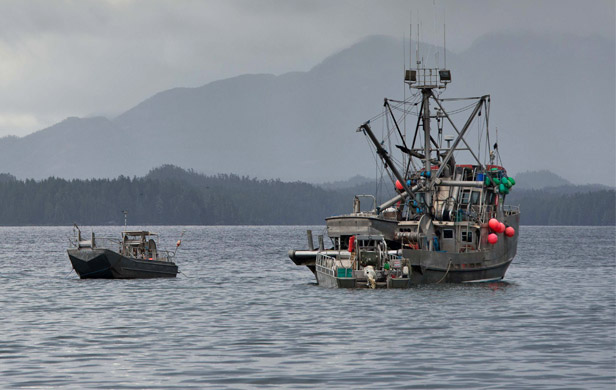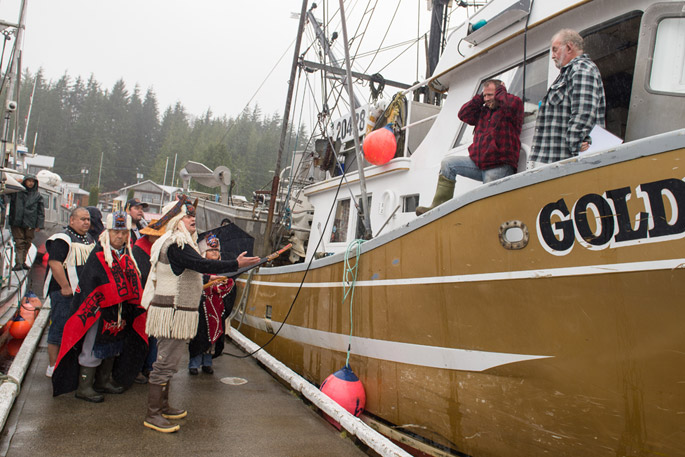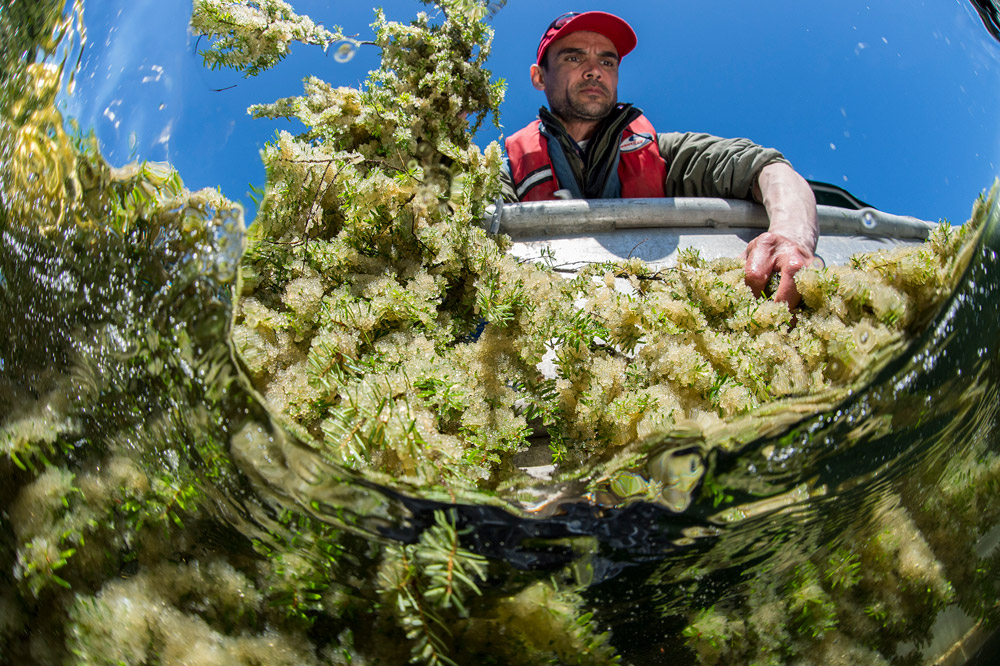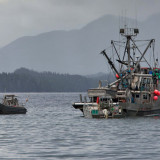
This is the untold story behind one of the most heated standoffs over fish which the BC coast has ever witnessed – the recent clash between the Department of Fisheries and Oceans (DFO) and the Heiltsuk Nation over the central coast herring fishery. After spending the better part of two weeks amid the conflict in Bella Bella and surrounding areas, I feel the convoluted affair – and its complex ecological, cultural and political implications – merits a deeper analysis.

On the surface, the reason the gillnet fleet left the central coast this past week, without the herring it had come for, is simple: There weren’t enough fish to sustain a commercial fishery – which is precisely what the local Heiltsuk Nation and independent scientists had been warning DFO all along. But don’t expect the hapless regulator to admit this obvious fact. Instead, it held onto the idea of a gillnet fishery to the bitter end.
Even after the fleet had pulled up stakes, DFO refused to bow to First Nations’ demands and formally close the fishery in Area 7. Only through emails to reporters much later did they finally acknowledge it was closed.
Caught on tape
A radio transmission from one gillnet captain to his counterparts, recorded by Pacific Wild – a conservation organization that has been documenting the central coast fishery – tells the tale. The conversation occurred on the herring grounds outside of Kitasu Bay, where the gillnetters had been granted an opening by DFO but simply couldn’t justify dropping their nets for a lack of fish. Here’s what the captain told his fellow fishermen:
[quote]It’s starting to cost everybody a bunch of money and if there’s no sizeable body of fish anywhere other than Higgins – I mean if you don’t see anything outside there, it ain’t gonna materialize out of nowhere now. You know, if there’s nothing sizeable then maybe we should all put our heads together and decide whether we want to continue this bullshit or pack it in.[/quote]
And that is precisely what they wound up doing soon thereafter (East Higgins – in the Heiltsuk’s declared Area 7 no-go zone would not prove to have the herring necessary for a fishery, despite remaining on the table, according to DFO, right to the end of this saga). But the boats did not leave because DFO told them to – this is an important distinction. As this transmission reflects, they left because there was simply no point carrying on.
> Listen to gilllnet fisherman’s communication – April 1, 2015:
Seiners clear out fishery
Industry voices may counter that there were fish in a few places kept off-limits by DFO and First Nations, but that’s an unfair criticism. For a several week period, all of Area 8 and virtually all of areas 6 and 7 – with a few tiny exemptions ultimately made for traditional Heiltsuk and Kistasoo/Xaixais food fish spots, such as Kitasu Bay – were open for fishing. It is a sad commentary on the state of the herring fishery that its success hinges on a single bay.
The fact of the matter is the seine fleet that took approximately 680 tonnes in an unannounced fishery in Spiller Channel essentially hoovered up what few viable fish there were (herring need to be of a certain size – roughly 20-plus centimetres in length – in order for the roe to be worthwhile). Even the seiners couldn’t achieve their own quota. In the wake of that fishery, nothing was left for the gillnetters, not to mention the Heiltsuk’s traditional fishery, which will likely suffer too.
For years, the Heiltsuk, backed by independent scientists, had been warning DFO about the lack of abundant stocks – to no avail. And when the department opened the sneak fishery in Spiller on March 22, it set off a bitter conflict that led the Heiltsuk to occupy the fisheries office near Bella Bella one week later.
As the days passed, a pattern emerged: DFO assured media they were in “discussions” with the Heiltsuk, but conference call after conference call failed to yield a solution. DFO would not bend and close Area 7.
The “Doctrine of Priority”

Now, a word about the complex world of herring fisheries. There are multiple types of herring fisheries on the central coast, each with different implications for conservation and informed by a landmark Supreme Court case called the Gladstone Decision of 1996. What that case essentially found is that the Heiltsuk had been engaged in their own commercial herring fishery since before contact and therefore maintain those rights today. It also established a “doctrine of priority” which laid out the order in which fish should be allocated by DFO.
The first priority is conservation, followed by the aboriginal right to food, social and ceremonial fish (FSC), then an aboriginal commercial fishery, and finally, after all those needs have been satisfied – and only if the stocks are healthy enough to justify it – a non-aboriginal commercial fishery.
DFO ignores the courts
Those who would seek to racialize the issue do so out of ignorance. To suggest that the Heiltsuk occupation of the DFO office and vow to stop the gillnet fishery “by any means necessary” is somehow lawless behaviour is inherently hypocritical. The Heiltsuk position is in fact entirely in line with the laws and jurisprudence of Canada – it is DFO which disrespected these institutions.
The Gladstone Decision is very clear about the allocation of fishing rights. The Heiltsuk, based on the historical record and the Constitution Act have first dibs. That’s not a value judgment – it’s a fact. In applying wrong-headed forecasting models to the fishery and ignoring Heiltsuk rights, DFO pitted aboriginal and non-aboriginal fishermen against each other, then stood back and did nothing to rectify the mess of their own making.
A different kettle of fish

There’s also a big difference between the commercial seine and gillnet fisheries and the traditional way the Heiltsuk do their food and commercial fisheries. The non-aboriginal commercial fishery is a “kill fishery”. The target in all cases is the precious roe – not so much the fish itself, which is used for pet food, bait or fish farm feed. Both seiners and gillnets scoop up the whole herring just for the roe. At one time this held immense value in Japanese fish markets for sushi. But today, prices are a fraction of what they once were, as the market is sitting on a huge backlog of frozen roe.
By contrast, the Heiltsuk employ a technique called spawn on kelp (SOK) for their FSC and commercial fisheries. Heiltsuk fishermen and families attach kelp to long lines and buoys and set them amidst the herring spawn. Some of the billions of eggs lain by the small fish deposit on the kelp and are then harvested. Another more boutique method involves tying hemlock boughs off the shoreline into the water, where herring roe also collects (my personal favourite, with the added bouquet of the forest).
The big difference is that with the SOK fishery, the herring aren’t killed, and swim free to spawn another day – making this a more sustainable fishery amidst depleted stocks.
DFO’s fuzzy math

In a typical healthy year, central coast First Nations would be allocated around 1750 tonnes of herring, with the non-aboriginal commercial fishery receiving something on the same order. But if there aren’t enough fish, then the commercial fishery is supposed to be closed and the Heiltsuk may even see their own allocation pared back for conservation purposes. According to retired DFO herring scientist Dr. Ron Tanasichuk, that’s precisely what should have happened this year.
Tanasichuk explained to me how DFO arbitrarily doubles its herring counts from the previous season, resulting in the over-allocation of fish:
[quote]The forecasting methodology that DFO uses now for central coast herring is actually quite flawed…DFO’s forecasts are likely twice as much as they should be.[/quote]
Numbers set in stone
The Heiltsuk presented Dr. Tanasichuk’s alternate calculations to DFO in a last-ditch meeting with Regional Director General Sue Farlinger this past Tuesday, but to no avail. Another problem with the department’s forecasting is that it’s set in stone once determined in September for the following year’s fishery. There is no mechanism by which to adapt allocations based on in-season soundings and observations from the actual fishery as it’s happening. Typical bureaucratic nonsense.
Dr. Tanisichuk’s alternate modelling predicted just over 14,000 tonnes of herring on the central coast this year (10% of which are available for a fishery) – about half of DFO’s forecasting. And guess what? Based on averaging out in-season soundings, he appears to have been right on the money. But this meant nothing to DFO.
Better call Ottawa
Farlinger flew out to Bella Bella on March 30 for emergency meetings following the Heiltsuk seizure of the DFO office. By most accounts, she did her level best to advance their concerns, securing agreements with the Heiltsuk to improved stock assessments and cultural training for local officers. But as for the big issue over closing Area 7, Farlinger maintained she did not have the authority to make a decision – which only compounded Heiltsuk frustrations with the federal government.
“It is my intention to avoid at all costs a fishery in Area 7,” Farlinger told a gathering of upset Heiltsuk members outside the occupied fisheries office. Yet, she added:
[quote]I’m not in a position to unilaterally say, ‘No fishery will happen in Area 7.'[/quote]
Instead, she told the community that she spent hours on the phone to her higher-ups in Ottawa, who plainly wouldn’t budge.
The incredible, shrinking DFO
In the end, as the gillnetters departed the central coast empty-handed, DFO would prefer that the public remained in the dark about what just happened up in Bella Bella.
And it shouldn’t. Herring are the building block of life on the BC coast. They need time to rebuild.
DFO should learn from this year’s herring fishery fiasco, start listening to scientists and working with the Heiltsuk to ensure a sustainable fishery for the future of herring and the ecosystems and coastal communities that depend on them.


Many thanks for a great article Damien.
The problem, as I see it, began with the DFO licence limitation initiative.
The then seine fleet of roughly 300 table seiners, 4 hours to make a set, increased to more than twice that number of drum seiners, 20 minutes to make a set. We all recall the DFO mantra …”Too many boats chasing too few fish!” It reality, licence limitation actually triggered an exponential increase in the power of the fleet to catch fish, not just herring, but salmon as well,
pulling the economic rug from under all the coastal communities that depended on the fishery.
I sometimes wonder if the motivation was crony capitalism?
Those of us interested in this issue may find the following book interesting. “Dead Fish and Fat Cats : A No-Nonsense Journey Through Our Dysfunctional Fishing Industry.
Herring are a precious resource, and we must take every step necessary to preserve them.
I am not a very scientific person or much of a fisherman but do you remember back twenty and more years ago when everyone with a sports fishing boat carried a herring rake as a very essential piece of equipment .
This allowed sports fishermen to easily rake herring for bait prior to fishing.
You never see a boat with a herring rake now a days because you never see herring like you used to. Dah?
“start listening to scientists and working with the Heiltsuk to ensure a sustainable fishery”, – also to add to this sentence in your write up, because heiltsuk knowledge has been ignored and considered ‘hearsay’, heiltsuk integrated resource management department has entered meaningful working and research agreements with scientists to corroborate their vast and deep knowledge with research tested data
I was a lighthouse keeper on the BC coast, the last 25 years on McInnes Island (Area 7) of Milbanke Sound on the Central Coast, about 40 kilometers from Bella Bella. I run the website lighthousememories.ca and I wrote an article on the herring spawn reflecting on my observations in 1977-78. It can be found here: http://lighthousememories.ca/2012/08/05/oops/
Even then to me, a novice, the abundance of the herring (and also lack thereof) was related to how many salmon I could or could not catch (as a sports fisherman)!
Maybe we should hire the Heiltsuk to head down to Woodfibre/Squamish and tell the LNG group a thing or too. And after that get involved in the raw lag fiasco. Maybe THEY should continue to occupy the DFO office.
Who is this FartLinger person and her “higher ups in Ottawa”? Maybe they should be replaced too?
Here’s an idea …shut down ALL fishing on our coast for two or so years that means everyone…were not going to die…let the fish stocks build up and then we can actually go out and catch a fish for dinner
I am proud of the first nations people, the Heiltsuk people in this case who have stood up to a government that represents no one known to me and thee. Herring are the grass for a grazing ocean. Take them away, and we’re all lost. Thank you also to the scientists and writers who have added their voices. Sincerely, Sally McMahon
There is one problem with your characterization of the Indigenous fishery. While it is correct that today the ‘traditional’ heiltsuk’ herring fishery is primarily a roe fishery, that has not always been the case. The archaeological evidence (one merely needs to check out work done by Lepovsky and Mckechnie) shows that for thousands of years Indigenous communities up and down the coast engaged in what you (so provocatively) call a kill fishery. Herring is tied with salmon as the most ubiquitous fish recovered through archaeological methods in ancient Indigenous villages along the coast.
This raises an important point about harvest methods and approaches. However, by using a deliberately overblown and inflammatory language in your article you imply a situation that is factually incorrect. Yet, you could make your point without that hyperbole.
Also, the segment of the recorded message is done in a fashion that only shows the segment of the radio conversation that supported your story. There was no sharing of the many points of view that would have been expressed on that conversation and throughout the fleet.
Yes, Charles, the Heiltsuk have engaged in gillnet fisheries in the past and even recently with their commercial licences – but they have voluntarily shut it down for the past decade or so. And in days when there were 200,000 tonnes of herring, that would probably have been fine – the evidence is the fact that they did a much better job as stewards than DFO ever has. They may also have caught fish to eat – but not at this time of year around the spawn; rather late summer or fall, when the meat is more suitable for consumption.
Anyway, I didn’t mean to convey the notion that the Heiltsuk have never seen a gillnet. I don’t think that’s the point in the present situation though
“Also, the segment of the recorded message is done in a fashion that only shows the segment of the radio conversation that supported your story. There was no sharing of the many points of view that would have been expressed on that conversation and throughout the fleet.”
This point is moot as the radio conversation would have had a lot of back and forth. What is important is not the entire conversation but the OUTCOME of the conversation and the revelation within;
For example until this article was posted I was hopeful that industry was listening to the FN on this issue.
While some may have been doing that, the posted part of the radio conversation reveals that this particular captain was concerned about his wallet.
“It’s starting to cost everybody a bunch of money and if there’s no sizeable body of fish anywhere other than Higgins……”
So in reality the fleet left the opening because they could not make any money.
“So in reality the fleet left the opening because they could not make any money.”
You got it, Dan.
No money because no viable fish.
Great Article Damien, you are missing a lot of facts though.Once Jimmy Patterson bought up BC Packers he owned 1/2 the licencing in the Herring Fishery. He now owns Ocean Fish, Bella Coola fish, Walcan fish and who knows what else. He pushed for a quota fishery in the 90’s and pretty much tells the fisheries what he wants.
Now if the stocks are that bad in shape all commercial fishing ,Native or non Native should be stopped.
You’re absolutely right about the consolidation of commercial fisheries in the hands of Pattison. Really, let’s call it what it is – a vertically-integrated monopoly with outsized influence on public policy around fisheries. No doubt about it.
That said, the reason I put the focus here on DFO is that it is the crown with whom the buck ultimately stops – it is their duty to consult and accommodate First Nations and implement the tenets of the Gladstone Decision, not the industry’s.
But you raise a valid point – one which the Heiltsuk and their supporters saw too in taking their concerns to Canfisco’s offices in Vancouver – as Dan Pierce documented in this clip we published:
https://vimeo.com/123286527
https://commonsensecanadian.ca/first-nation-taking-herring-concerns-to-jimmy-pattisons-canfisco/
I would like to see a cost breakdown of the monies spent for the many RCMP members that came to Bella Bella, including the boats and planes they used, accommodations, meals, etc. Our tax dollars at work!!
Thank you, Damien, for this helpful article.
Far too few Canadians understand that DFO was actually *created* in order to allow politicians to override fisheries scientists’ advice regarding conservation. That statement is not hyperbole or conjecture — it is the thoughtful conviction of three distinguished Canadian fisheries scientists (Jeff Hutchings, Carl Walters and Richard Haedrich) who published a peer-review article about it in the “Canadian Journal of Fisheries and Aquatic Sciences” in 1997. The reference is CJFAS, v.54, pp.1198–1210.
In over 25 years of wilderness travel on the BC coast I have come to greatly respect the Heiltsuk people. They have not sold out to any industry or to any level of government. Their national territory is a stunningly beautiful and bio-productive complex of islands, inlets and rivers that is unique to Pacific Canada. They do their best to maintain and protect it, and they teach their children to do the same. They do all of that in a spirit of generosity.
Thank you for sharing this story, Neil. Scientists like yourself and the distinguished group you mention know what they’re talking about, yet so often we see politics trumping that wisdom – not to mention the traditional knowledge of First Nations like the Heiltsuk. No matter what the specific issue, the pattern at DFO seems the same – and that’s what needs to change if we want to hang onto our fish.
Thanks for the breakdown. Clearly DFO has no clue, as usual, same old same old. They have closed fisheries on the Fraser in the past when they realized there were virtually no sockeye returning in spite of having set commercial and aboriginal fishing quotas. That’s another kettle of fish!
It has been, and is my conclusion that the DFO, a long with the other resource regulating agencies in our government, have sold out to the industrialized, large scale, foreign and domestic, corporate interests.
The presence of a purse seiner, owned by the Jim Patterson Group makes that obvious. This company own’s 9 such boats, clearly, their primary interest is not preservation, but the maximum exploitation, of anything swimming in our oceans, as well as all of the other non renewable resources that this country provides, despite the obvious, well known effects and consequences.
The Heiltsuk are leading the way…leave the herring in our strait also